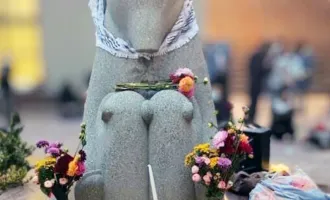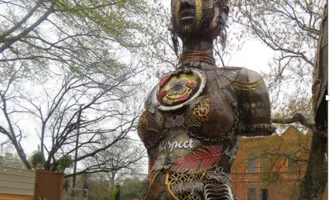
This Date in UCSF History: Guard Affirmative Action
Originally published in Synapse on February 20, 1983.
Come with me on a brief journey into the past, the not too distant past, I might add. it is the year of 1968.
I would like to share with you what it was like for blacks during those days prior to the founding of the Black Caucus. We numbered approximately 1,000 to 1,200.
Our jobs were mostly in the lower level classifications, i.e. janitors, lab helpers, patient escorts, maids, laundry workers, clerks, truck drivers and laborers. A few were in professional positions, such as employment representatives, lab. techs and supervisory jobs.
The vast majority of blacks were employed by the General Services Department. This department was the modern version of the urban plantation. The plantation was complete. It had a plantation boss, house n****s and field n****s. The boss hired and fired and chastised based on his whim, at the moment.
At least 85 percent of the black people on campus worked for this plantation boss. His methods and practices were condoned by higher campus administration. Higher level positions were at that time unavailable to blacks. The system clearly communicated to us, “do not apply. You will not be accepted.”
It was the sixties, and the country was suffering from national racial unrest. The campus had made some feeble efforts to recruit minority students under the leadership of the late Dr. Nat Burbridge. This effort did not change appreciably the composition of the professional schools.
The school of dentistry had not graduated black students for 19 years, it was reported. It is fair to say that UCSF’s commitment to equal opportunity was shameful and shocking. It was not an environment in which minorities, especially blacks, faired well.
But outside events were beginning to have their effects on campus. S.F. State University was experiencing racial crisis, as were other places across the nation. The sudden death of Dr. Martin Luther King Jr. sent shock waves through the nation.
His assassination raised the consciousness of the entire campus, especially the black community.
Blacks at UCSF felt the time to act had come. Enter the Black Caucus Less than a month after the death of Dr. King, Jr. the Black Caucus was organized.
On May 4, after a series of organizational meetings, the Black Caucus called the entire black community together in our first major campus general meeting. Top administration was concerned.
Our task was clear. The time was ripe to deal with the pangs of racism that had too long gone unchecked and unchallenged.
We were dedicated in our resolve to bring about the kind of change that ultimately would improve our lives at UCSF. The founding conference produced the “Black Manifesto,” which listed brilliantly the concerns that we faced on this campus.
The Black Manifesto listed numerous complaints and one specific request: that the plantation boss be dismissed. The document was delivered to the late Dr. Williard Fleming, Chancellor. Chancellor Fleming presented to each department mentioned in the Black Manifesto, a request that they answer the charges made by the Black Caucus.
All of the departments complied except the General Services.
The plantation boss chose to resign. The Black Caucushad achieved its first major victory.
Numerous activities followed, including the development of an apprenticeship program for minorities, on-the-job training for advancement and reclassification of minorities who previously had been turned down.
We also turned to the issue of student recruitment. The campus adopted a 25 percent goal of minority placements for each professional school.
We pressed the campus to increase the hiring of black faculty. In 1970, in answer to Black Caucus demands, the Affirmative Action Office was set up. The BC successfully urged the campus to hire more minority youths, resulting in the beginning of the Chancellor’s summer youth program.
This program continues today.
The BC was able to have the Personnel Department look into the question of why UC Berkeley’s custodians were classified as custodians, while UCSF classified its maintenance workers as janitors and paid them less than the custodial salary. Research indicated that the duties were very much the same.
This campus changed the janitors’ classification to custodian and gave them an 18 percent salary increase. A little-known change which the BC was responsible for is opening up the Millberry Union membership to staff. Prior to the BC, staff could not become members in the MU.
It also should be mentioned that the White Caucus was formed not in opposition to the Black Caucus, but in support of it.
The White Caucus consisted of concerned whites from the staff and faculty. The Black Caucus was highly successful in bringing together student, staff and faculty in a united front to fight racism on this campus.
No other campus in the UC system was able to accomplish this feat. The results of that effort are still with us. The danger exists, however, that important gains are being lost; this is evidenced by the decline of blacks from the campus.
Since about the late seventies, the BC has undergone a series of ups and downs. The issues were not as clearly defined later as during the late sixties.
Those willing to serve in leadership roles were difficult to find. New employees coming on campus were not as in-tuned with the goals of the caucus.
At times, we had difficulty articulating just where the emphasis should be placed. This resulted in representing black employees on a one-to-one basis.
We found ourselves handling more and more grievances, rather than making the broad institutional changes which I personally think the caucus does best, and should be doing.
The campus affirmative action program did not deliver what many of us thought it should.
There appeared to be confusion as to just what affirmative action should be doing. The affirmative action office is staff to line management. It is not, as some would like it to be, an advocate for protected groups. Perhaps we expected much more.
The problem is that without a strong pressure group, affirmative action left alone is nothing. The BC slacked off after the AA office was set up. I consider this a mistake. Pressure must be continuously applied. So much for the past.
The real question is, what about now and the future?
The now of the BC is of an organization without a direction. There is a leadership vacuum. Past leaders are prone to want to dictate to the new leaders. There is apathy in the ranks. New staff know little of the past victories, and in some cases care little.
Organizing in this kind of climate is difficult, if not impossible. I am a pragmatist; I try to see the world realistically. If the caucus is to survive, new directions must be found. New methods must be adopted.
The rank and file must become excited that something can be done. And that something must be clearly identified and supported. The crucial question is: how long can an organization live off of past victories?
So, we find ourselves in 1983, not able to affect the kinds of changes that took place in the sixties. This is different era, with different issues. However, racism still exists. Affirmative action at its best cannot deliver us.
So what do we do? I don’t propose to be a sage, and I am not presumptuous enough to think I have the answer. However, I do have some thoughts on the subject.
During the sixties, a supportive climate existed here, and the events of history were on our side.
The caucus in practical terms was a coalition. It consisted of concerned whites, staff, labor, students and faculty.
This broad support gave added strength to the movement. I believe that the third world people at UCSF today must unite.
We have divided ourselves around ethnicity, culture and sex. Cultural and ethnic groups have their places, but what good is a weak Black Caucus, a weak Latin American campus union, a weak Asian organization, and a weak women’s group?
We need people, I think: a united caucus. The time has come to stop participation in a divide-and-conquer process.
You must remember, the present federal administration is hostile, and affirmative action programs are under attack.
I believe that now, more than ever before, a strong coalition is needed, dedicated to affirmative action and improved social climate.
If we are to survive the present crisis, we must work toward this end.



